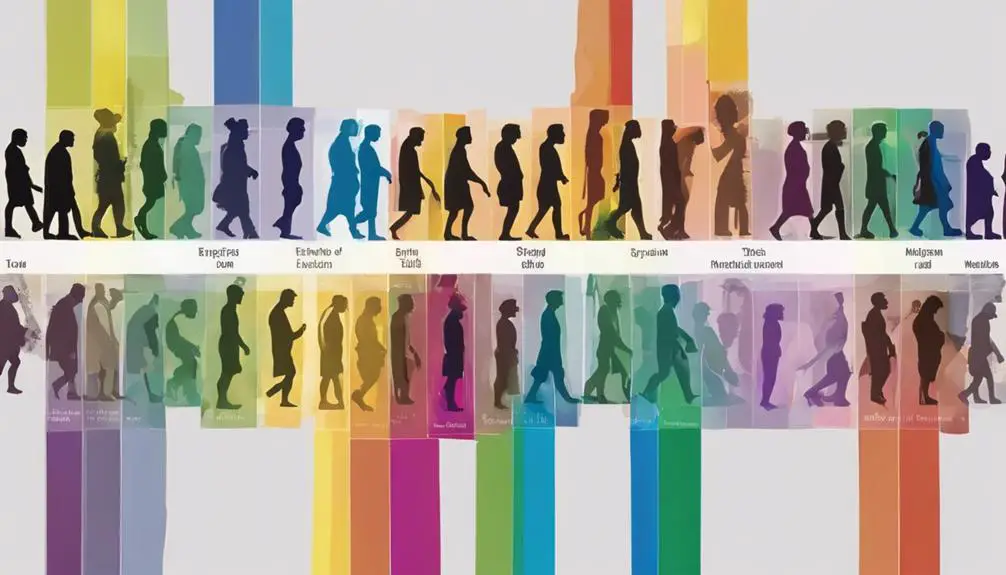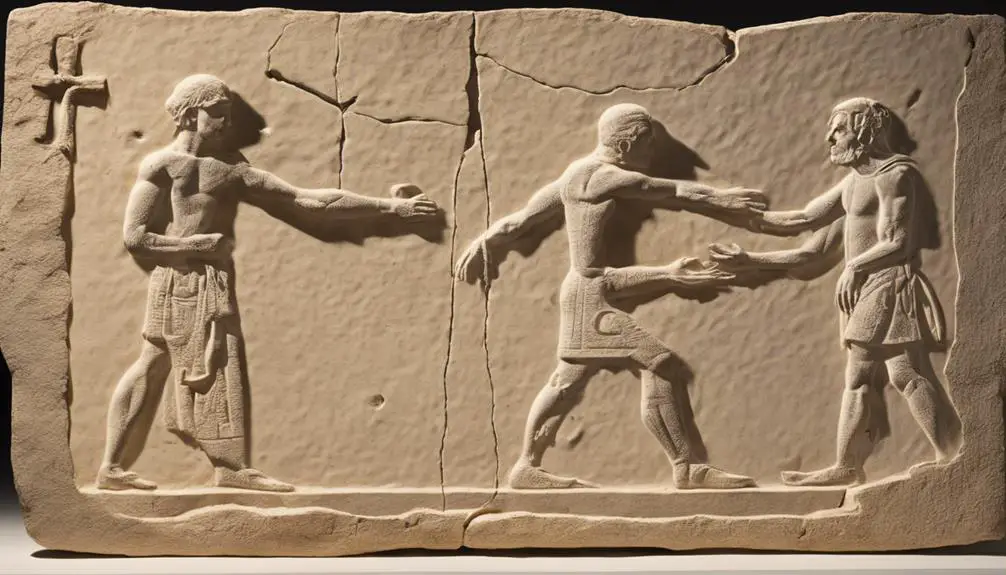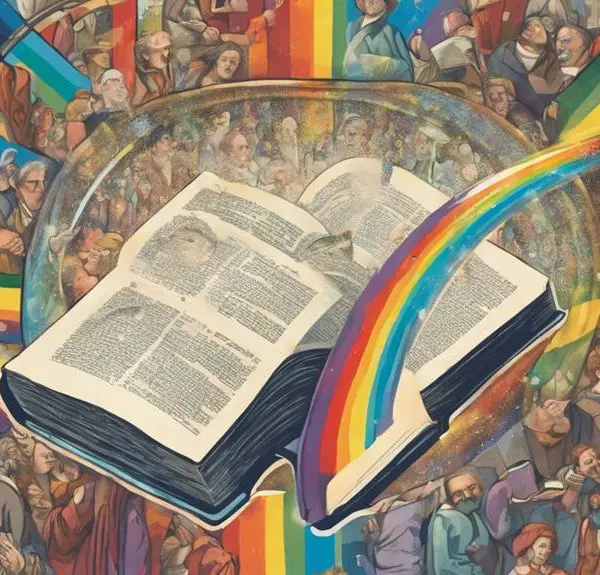Yearning to understand the Bible's stance on homosexuality? Delve into the historical and linguistic context for potential misinterpretations.

Are the Bible Versed About Gayness Miscontrued
Peering through the keyhole of history, you might find the Bible's stance on homosexuality to be an enigma wrapped in a riddle.
The verses often cited in relation to this topic have sparked contentious debates centered around their original intent and how they're interpreted today.
But what if the common understanding isn't as cut and dry as it seems? Perhaps, much like a cryptic crossword, the answer lies not in the question but in the clues scattered throughout the historical and linguistic context.
Are you ready to unravel the mystery?
Key Takeaways
- The Bible's references to homosexuality are subject to interpretation due to linguistic, historical, and cultural contexts.
- The original Hebrew and Greek texts offer nuanced meanings, contributing to varying interpretations of homosexuality-related verses.
- Theological perspectives on homosexuality have evolved, reflecting the changing societal norms and attitudes.
- Modern debates on biblical texts related to homosexuality highlight the importance of context and evolving interpretations in contemporary society.
Understanding Biblical Texts

To fully grasp the biblical perspective on homosexuality, it's crucial that you first understand the context and interpretation of various biblical texts. The Bible isn't a single book, but a collection of texts written over centuries. The authors wrote in different languages, styles, and cultural contexts, which can lead to diverse interpretations.
You'll find references to homosexuality in both Old and New Testaments. In the Old Testament, Leviticus 18:22 and 20:13 are often cited, while in the New Testament, Romans 1:26-27, 1 Corinthians 6:9-10, and 1 Timothy 1:10 are frequently referenced. However, the interpretation of these verses is contentious. It's worth noting that the term 'homosexuality' didn't exist until the 19th century, and the original texts used different terminology, which complicates translation and interpretation.
Furthermore, the Bible's teachings are often nuanced and context-specific. For instance, the Levitical laws were directed at a specific community at a specific time. Thus, understanding these verses requires a comprehensive grasp of their context, which includes linguistic, historical, and cultural aspects. This intellectual exercise can shed new light on the biblical perspective on homosexuality.
Historical Context of Scriptures

Understanding the historical context of these scriptures can significantly impact how you interpret the aforementioned verses on homosexuality. You must remember that the Bible was written in a vastly different time, where societal norms, language, and understanding of human sexuality weren't as they're today.
For instance, in ancient times, homosexuality wasn't recognized as an identity or orientation as we understand it today. Sexual acts between men were often associated with power dynamics, idolatry, or ritualistic practices. It's plausible that Biblical admonishments against such acts were condemning these specific contexts, not homosexuality as a whole.
Moreover, marriage in the Bible had a different purpose, often serving as a means for procreation and securing family lineage, rather than a union born out of love and mutual consent. This could have influenced the Bible's teachings on sexual relations.
Linguistic Interpretations Explored

Delving into linguistic interpretations, you'll find that the original Hebrew and Greek texts of the Bible can offer nuanced perspectives on its teachings about homosexuality. Ancient languages often lack direct parallels to modern terms, creating ambiguity in translation.
For instance, you'll encounter the Hebrew term 'toevah' in the Leviticus passages often cited in discussions of homosexuality. While commonly translated as 'abomination,' scholarly research suggests the term more accurately refers to a cultural taboo, often associated with non-Israelite practices. This suggests that the condemnation might be more about maintaining cultural boundaries than categorically denouncing homosexuality.
In the New Testament, the Greek words 'malakoi' and 'arsenokoitai' are found in key verses. These terms have been translated into English as 'effeminate' and 'homosexuals,' respectively. However, the precise meanings of these words remain disputed. Some scholars propose 'malakoi' refers to moral weakness, while 'arsenokoitai' may relate to exploitative sexual practices rather than a blanket condemnation of same-sex relationships.
Therefore, understanding the Bible's teachings on homosexuality demands careful consideration of linguistic nuances. These complexities highlight the necessity for informed, scholarly analysis when interpreting ancient texts on contemporary issues.
Evolution of Theological Perspectives

As you explore the evolving theological perspectives on homosexuality, you'll notice shifts in interpretations and attitudes over time, reflecting societal changes and ongoing scholarly debates. These shifts have been marked by varying degrees of acceptance and rejection, often influenced by cultural, political, and social contexts.
In early Christian thought, homosexuality was generally condemned, largely influenced by cultural norms and interpretations of biblical texts. However, during the Middle Ages, some theologians began to differentiate between homosexual desires and acts, suggesting that the sin lay in the action rather than the orientation.
The Enlightenment period brought forth more progressive interpretations. Some theologians started questioning previous assumptions, challenging the literal interpretations of Bible verses related to homosexuality. They proposed that these verses should be understood within their historical and cultural contexts, leading to a more nuanced approach.
In recent years, a growing number of theologians have advocated for full inclusion of LGBTQ+ individuals in religious communities, arguing for an interpretation of biblical texts that emphasizes love and acceptance. This shift mirrors broader societal trends towards acceptance and equality. However, these interpretations remain contested, reflecting the complexity and diversity of theological perspectives.
Controversies and Modern Viewpoints

Despite the evolution in theological perspectives, controversies persist in modern viewpoints about homosexuality in the Bible. You'll find an array of interpretations, ranging from acceptance to outright condemnation, reflecting the complex relationship between religious faith and societal norms.
Scholars and theologians continue to grapple with verses like Leviticus 18:22, 1 Corinthians 6:9-10, and Romans 1:26-27, which are often cited in debates about the Bible's stance on homosexuality. Some argue these verses explicitly condemn same-sex relations, while others contend they've been misinterpreted or mistranslated.
Critics of more conservative interpretations point out that Biblical texts should be understood in their historical and cultural context, and that the concept of homosexuality as we understand it today didn't exist in Biblical times. Conversely, proponents of these interpretations maintain that the Bible's teachings are timeless and universal.
The ongoing controversy underscores the struggle to reconcile faith with changing societal attitudes towards sexuality. It's a reminder that interpretations of religious texts aren't static, but evolve with our understanding of human nature and morality. The question isn't whether the Bible's verses about gayness are misconstrued, but how we choose to understand and apply them in our own lives.
Conclusion
In conclusion, you've seen how biblical verses about homosexuality can be misinterpreted, due to historical context and linguistic nuances.
The evolution of theological perspectives and ongoing controversies reveal a complex picture.
It's clear that interpretations can vary widely, reflecting our diverse worldviews.
Therefore, it's crucial to approach these texts with an open, scholarly mind, acknowledging the potential for different, valid interpretations.



Sign up